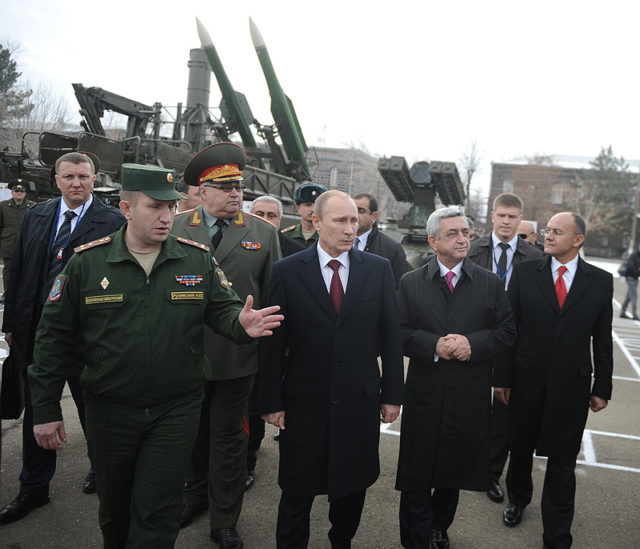
Armenia and Russia Pursue Joint Military Forces
Publication: Eurasia Daily Monitor Volume: 13 Issue: 188
By:

Russian President Vladimir Putin has approved an agreement to establish a joint Russo-Armenian military unit, which will include troops of the 102nd Russian military base stationed near Yerevan as well as the 4th Corps of the Armenian Army. The unit’s commander is to be appointed by the Armenian president after consultations with his Russian counterpart. In peacetime, it will be subordinated to Armenian military structures; while in wartime, Russia’s Southern Military District will take command (Rosbalt.ru, November 21). The planned joint military unit represents only the latest example of Russia’s growing military buildup in the South Caucasus region.
The Russo-Armenian agreement predictably caused an adverse reaction in Azerbaijan. But the clause about Russian command of the joint unit in case of war, together with Moscow’s extended control over the Armenian border guard and customs service, caused anxiety in Armenia as well (Rosbalt.ru, November 21). Some Armenian observers questioned Russia’s motivation and possible unwillingness to become engaged in case of an attack on Armenia by Azerbaijan. Indeed, they again pointed out that Russia is also Azerbaijan’s main supplier of arms (Lragir.am, November 14). Such skepticism is not entirely ungrounded. Indeed, neither Russia nor any of Armenia’s other Collective Security Treaty Organization (CSTO) allies have ever identified Azerbaijan as a potential threat—even during those occasions when Armenia’s north-eastern regions were shelled by Azerbaijani forces. Meanwhile, the parallel process of the militarization of Georgian territories under Russian occupation—Abkhazia and South Ossetia—suggests Russia is pursuing its own interests that presuppose a need to confront the North Atlantic Treaty Organization (NATO) on all fronts (Tbilisi remains an enthusiastic NATO aspirant). So, although the joint military unit is supposed to deal with common security threats, Armenia and Russia do not actually share a common adversary (Aravot.am, November 24).
According to Georgian sources, on November 23, the Gali region in Abkhazia, where the majority of the population is ethnically Georgian, was declared a militarized zone under the pretext of border protection. The local residents there may soon face strict limitations on their freedom of movement. Russia plans to deploy 3,000 troops and build a military airfield in the region (Apsny.ge, November 24). Russian sources also admit that the country’s wider military buildup in the South Caucasus is aimed at “containment” of the North Atlantic Alliance and at control of Georgia. As the state news agency RIA Novosti notes, Moscow expects to deal with possible local conflicts resulting from NATO’s policies in the Middle East, the Baltic States, Ukraine and the Caucasus. The Substantial NATO-Georgia Package (adopted during the July 2016 Warsaw Summit) and NATO’s exercises in Georgia were particularly mentioned as grounds for Russia’s countermeasures (RIA Novosti, November 14). Some publications include more open threats addressed to Georgia. They mention Russian Iskander-M (SS-26) short-range ballistic missiles stationed in Armenia as a potential threat to Georgia’s hydrocarbon transportation infrastructure, as well as note that Georgia is practically surrounded by Russian troops (Rosbalt.ru, November 21).
The continuing Russian military buildup in the South Caucasus is generally in line with Moscow’s plans revealed a few years ago. Previously, the 102nd base was already expected to make “preparations for engagement against a potential adversary’s rear,” and Georgia was seen as the most likely adversary. In addition to such statements, some of Russia’s practical steps caused concerns in Georgia, expressed by experts, as well as state officials, including President Giorgi Margvelashvili (see EDM, April 2, 2015).
While a potential deterioration of relations with Georgia would undermine Armenia’s national interests, the government in Yerevan appears willing to make this sacrifice in the name of regime reproduction and survival. The sitting government will arguably need to seek external legitimacy from Russia to win in the general elections scheduled four months from now. But that, in turn, will require giving up ever more concessions to Moscow—presumably also in the defense and security sphere.
The socioeconomic situation in Armenia looks exceedingly likely to continue to deteriorate. The government of Prime Minister Karen Karapetyan (confirmed on September 13) has pointedly pledged to fight corruption and domestic monopolies, but this promise is already turning out to be little more than empty rhetoric. The swift licensing by the authorities of Max Petrol, a new motor fuel importer company, was widely publicized as a positive achievement of the new Karapetyan cabinet. But this supposed accomplishment was almost immediately compromised when it was revealed that Max Petrol—a company with a registered share capital of 100,000 dram (about $210)—had actually been registered a week before Karapetyan’s appointment (Armtimes.com, November 10). Another widely publicized initiative, the “nation-army,” is highlighting the government’s unwillingness to compel businesses belonging to oligarchs to pay taxes (see EDM, October 31). Instead, the nation-army concept is becoming a pretext for levying a new tax on the general population. The associated draft law on the nation-army concept passed its first reading unusually quickly, within about two weeks after filing the proposal. It provides that all legally employed citizens will have to pay 1,000 dram ($2) a month—even though the minimum monthly salary in Armenia is only 55,000 dram ($114.50). Before the second reading, some lawmakers suggested considering the possibility of an opt-out for this tax; but the minister of defense rejected it (Panarmenian.net, November 26).
The decision to reduce the natural gas fee starting in January 2017 may be the government’s only move enabling it to gain some popularity. The fee is going to be reduced by 5.3 percent for households and by 15.65 percent for industrial consumers (Azatutyun.am, November 25). Obviously, such a price drop is only possible by means of an agreement with Gazprom, which in turn will likely require a political decision by Moscow. So, a further tradeoff is probable—once more securing regime succession in exchange for trading away some components of Armenian sovereignty to Russia.



